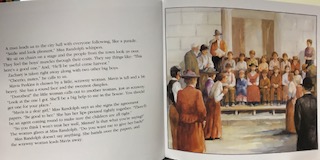
Title: Train to Somewhere
Author: Eve Bunting
Illustrator: Ronald Himler
Publisher: Clarion Books
Year: 1996
Number of Pages: 32
Tags: Emotion, Family, Friendship, Historical fiction, Picture Book, K-5, Taylor Krueger
Genre: Historical Fiction Children’s Book
Analysis: This book shares the story of a young orphan girl, Marianne, on her journey to find a family. It shows her trip on the orphan trains and the stops along the way where people chose orphans to join their family. Throughout the book Marianne is waiting to see her mother’s face at one of the stops, but never finds her. The journey is tiring and allows Marianne to find strength and hope in herself to persevere and end up with a caring family.
The illustrations of this book take up one whole page. The images are bordered with a thin black line that keeps them from going to the edge of the page. These borders are thin which could represent the speed of the train, as the characters are constantly moving on their journey to find a family. The framed illustrations allow only a limited glimpse into the world of the characters. The reader seems to be always watching from afar rather than being present in the scenes. The illustrations create a window effect for the reader by  allowing the reader to look into another world of the past. It lets the reader peer into the lives and feel the emotions of the characters during their journey. There are throughout the book small illustrations that are present on the pages that contain the text. They are always images of the train traveling to its next stop, which shows the scenery and setting of the locations.
allowing the reader to look into another world of the past. It lets the reader peer into the lives and feel the emotions of the characters during their journey. There are throughout the book small illustrations that are present on the pages that contain the text. They are always images of the train traveling to its next stop, which shows the scenery and setting of the locations.
The colors used throughout the book are very warm and connect to the story and emotions of the characters. There are not many bright colors as a majority of the time the use of browns, beiges, and grays are present. The illustrator used watercolors to illustrate the book, which adds great depth to the images and characters. It’s very eye catching and interesting to look at from the reader’s perspective. There is a bright use of color to represent the jacket of the character Nora, who was close friends with Marianne. The bright color blue is used to show her youth and innocence throughout the book.
The illustrations of the characters and settings have the perceptual view of orphan children finding a family to call home. There are depictions of young children jumping into the arms of their new parents, children riding the train, and the fear of many while at the train stops. The structural view of the characters show a representation of hope. There is a constant pattern of facial expressions of the characters throughout the book as the beginning illustrations show sadness and worry that the orphans will never be picked. Throughout the novel the succession of children being picked and joined with a family shares facial expressions of happiness and comfort of finding a home. For the most part all of the orphan children are shown to be the same size, but there are moments where the more valued children are illustrated larger and have more youthful facial expressions.
This book shows the historical ideological issue of orphan trains and children without homes and families. It gives information on a topic that might have been unknown by the reader. It shows the transformation of children coming from orphanages and finding a caring family. It allows young children to understand the stories of the characters and the struggles of their journeys.
This book is a representation of a multimodal text. There is an interaction between the text and the illustrations that use each other to fill in the gaps for the reader. The illustrations further elaborate the meaning of the text and gives the reader a visual representation of the words. The text and illustrations enhance the message of the story and helps share the history of the orphan trains. They are both equally important in order for this message to be understood by the reader.
The introduction of the book elaborates the story of the characters and gives background information of the orphan trains. It allows the reader to further understand the impact the orphan trains had on children and their newfound families, as there were a lot of children who went through this journey. The introduction shares to the reader that this book is based on true events, but the characters and locations are fictional.
